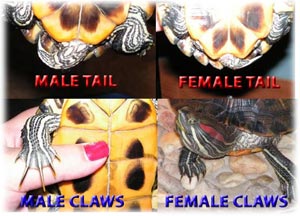For most turtle owners, figuring out how to determine the gender of their red eared slider isn’t a big deal. They have one turtle living comfortably in its tank and its sex simply isn’t important. However, quite often curiosity strikes and people simply want to know. Some slider hobbyists, on the other hand, want to breed their turtles or house multiple turtles in one habitat. For these reasons, you definitely need to know whether your turtles are male or female. T he first step you need to take if you want to determine the gender of your red eared slider is to look at the bottom of your turtle. Do not turn it over to do this, as it may be bad for your turtle’s health. Simply lift it up and take a look. If the bottom of the shell is concave (bulging inward), then your slider is probably male. If the bottom of the shell is flat or slightly convex (bulging outward), then it is probably female. Male turtles have concave shells because it helps them mount the top of the female’s curved shell for breeding. The next step in determining the gender of your red eared slider is looking at its tail. If the turtle’s cloaca, the orifice in which its sex organs are located and through which it excretes waste, is located halfway between the turtle’s body and the tip of its tail, it is probably male. If the cloaca is located closer to the body (almost under the shell), the turtle is probably female. The location of the cloaca once again has to do with breeding. During copulation, the male mounts the female, so his cloaca needs to be able to reach hers. Its location (further away from the body), makes this much easier. You can also look at the thickness of the turtle’s tail – males usually have thicker tails than females. The final step to find out your red eared slider’s gender, if none of the above methods are conclusive, is to look at its front claws. In general, male red eared sliders have very long front claws that they use in their mating dance. The only exception to this rule is males that have been kept in inadequate conditions; such turtles are often underdeveloped and lack the long claws. Hopefully these methods will help you determine the gender of your red eared slider. If none of the above methods work for you, contact your local reptile veterinarian or reptile expert for a definitive answer.
he first step you need to take if you want to determine the gender of your red eared slider is to look at the bottom of your turtle. Do not turn it over to do this, as it may be bad for your turtle’s health. Simply lift it up and take a look. If the bottom of the shell is concave (bulging inward), then your slider is probably male. If the bottom of the shell is flat or slightly convex (bulging outward), then it is probably female. Male turtles have concave shells because it helps them mount the top of the female’s curved shell for breeding. The next step in determining the gender of your red eared slider is looking at its tail. If the turtle’s cloaca, the orifice in which its sex organs are located and through which it excretes waste, is located halfway between the turtle’s body and the tip of its tail, it is probably male. If the cloaca is located closer to the body (almost under the shell), the turtle is probably female. The location of the cloaca once again has to do with breeding. During copulation, the male mounts the female, so his cloaca needs to be able to reach hers. Its location (further away from the body), makes this much easier. You can also look at the thickness of the turtle’s tail – males usually have thicker tails than females. The final step to find out your red eared slider’s gender, if none of the above methods are conclusive, is to look at its front claws. In general, male red eared sliders have very long front claws that they use in their mating dance. The only exception to this rule is males that have been kept in inadequate conditions; such turtles are often underdeveloped and lack the long claws. Hopefully these methods will help you determine the gender of your red eared slider. If none of the above methods work for you, contact your local reptile veterinarian or reptile expert for a definitive answer.











